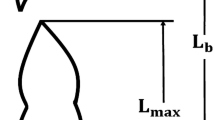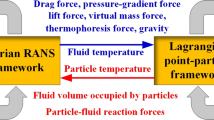Abstract
Interior ballistics are completed in tens of milliseconds, as are all gun-firing phenomena. Thus, some data cannot be measured directly through experimentation. Therefore, such complex gun-firing phenomena are traditionally clarified by numerical analysis. In the twophase flow of interior ballistics, interphase drag has a strong effect on propellant particle movement. This drag is a momentum sink in the gas phase and a corresponding source of momentum for the solid phase. Previous studies have calculated the drag force on the propellant particles using Ergun’s empirical equation, which was developed for a dense bed and relates the drag to the pressure drop through porous media. However, the particulate bed is fluidized in the course of the cycle of interior ballistics, thus indicating that the flow field is transient with regions of high Reynolds number beyond the range of experimental data. The Ergun equation is examined through a compensation study and calibrated based on the Reynolds number using the numerical method. Moreover, the influence of different drag models on flow behavior and propellant movement in interior ballistics is analyzed.
Similar content being viewed by others
References
S. Paul Gough, Initial development of core module of next generation interior ballistic model NGEN, ARL-CR-234 (1995).
J. Michael Nusca and W. Albert Horst, Progress in modeling ignition in a solid propellant charge for telescoped ammunition, ARL-TR-3673 (2005).
K. Otto Heiney and J. Robert West,: Interior ballistics, muzzle flash and gas gradients of aircraft cannon, AFATL-TR-76-34 (1976).
H. G. Sung, J. S. Jang and T. S. Roh, Application of Euler- Lagrangian approach to gas-solid flow in interior ballistics, Journal of Applied Mechanics, 80 (2013) 031407.
J. S. Jang, H. G. Sung, T. S. Roh and D. W. Choi, Numerical analysis of interior ballistics through eulerian-lagrangian approach, Journal of Mechanical Science and Technology, 27 (8) (2013) 2351–2357.
S. Ergun, Fluid flow through packed columns, Chem. Eng. Prog., 48 (2) (1952) 89–94.
S. Y. Yoo, T. G. Lim, S. B. Lee and T. S. Roh, Computational analysis of pressure drop in pipe according to cylindrical particle and numerical calibration analysis of Ergun’s equation, KSCFE (2011) 160–165.
K. Papadikis, S. Gu, A. Fivga and A. B. Bridgewater, Numerical comparison of the drag models of granular flows applied to the fast pyrolysis biomass, Energy & Fuels, 24 (2010) 2133–2145.
R. Acharya and K. Kuo, Implementation of approximate riemann solver to two-phase flows in mortar system, ASME J. Appl. Meth., 77 (2010) 051401.
M. R. Baer and J. W. Nunziato, A two-phase mixture theory for the deflagration to detonation transition in reactive granular materials, Int. J. Multiphase Flow, 12 (6) (1986) 861–889.
J. Nussbaum, P. Helluy, J. M. Herard and B. Baschung, Multi-dimensional two-phase flow modeling applied to interior ballistics, ASME J. Appl. Mech., 78 (2011) 051015.
M. A. van der Hoef, M. van der Sint Annaland, N. G. Deen and J. A. M. Guipers, Numerical simulation of dense gassolid fluidized beds: A multiscale modeling strategy, Annu. Rev. Fluid Mech., 40 (2008) 47–70.
H. G. Sung, Study on characteristics of interior ballistics with gas solid flow through Eulerian-Lagrangian approach, Ph.D thesis, Inha University (2012).
C. T. Crowe, M. P. Sharma and D. E. Stock, The particlesource in cell(PSI-CELL) model for gas-droplet flows, ASME J. Fluids Eng., 99 (2) (1977) 325–332.
D. Ronald Anderson and D. Kurt Fickie, IBHVG2-A User’s Guide, BRL-TR-2829 (1987).
E. Shima, A compressible CFD method for flow with sound from very low mach number to supersonic, 6th International Colloquium on Bluff Bodies Aerodynamics and Applications (2008).
Clive Woodley, Alain Carriere, Patrice Franco, Julien Nussbaum, Xavier Chabaux and Baptiste Longuet, Comparisons of internal ballistics simulations of 40 mm gun firings, 23rd International Symposium on Ballistics (2007).
Clive Woodley, Alain Carriere, Patrice Franco, Julien Nussbaum, Xavier Chabaux and Baptiste Longuet, Comparisons of internal ballistics of the AGARD gun, 22nd International Symposium on Ballistics (2005).
Author information
Authors and Affiliations
Corresponding author
Additional information
Recommended by Associate Editor Hyoung-gwon Choi
Tae-Seong Roh received his B.S. and M.S. degrees in Aeronautical Engineering from Seoul National University in 1984 and 1986, respectively. He then went on to receive his Ph.D. from Pennsylvania State University in 1995. Dr. Roh is currently a Professor at the Department of Aerospace Engineering at Inha University in Incheon, Korea. His research interests are in the areas of combustion instabilities, rocket and jet propulsions, interior ballistics, and gas turbine engine defect diagnostics.
Rights and permissions
About this article
Cite this article
Jang, JS., Oh, SH. & Roh, TS. Comparison of the characteristics of granular propellant movement in interior ballistics based on the interphase drag model. J Mech Sci Technol 28, 4547–4553 (2014). https://doi.org/10.1007/s12206-014-1022-5
Received:
Revised:
Accepted:
Published:
Issue Date:
DOI: https://doi.org/10.1007/s12206-014-1022-5




